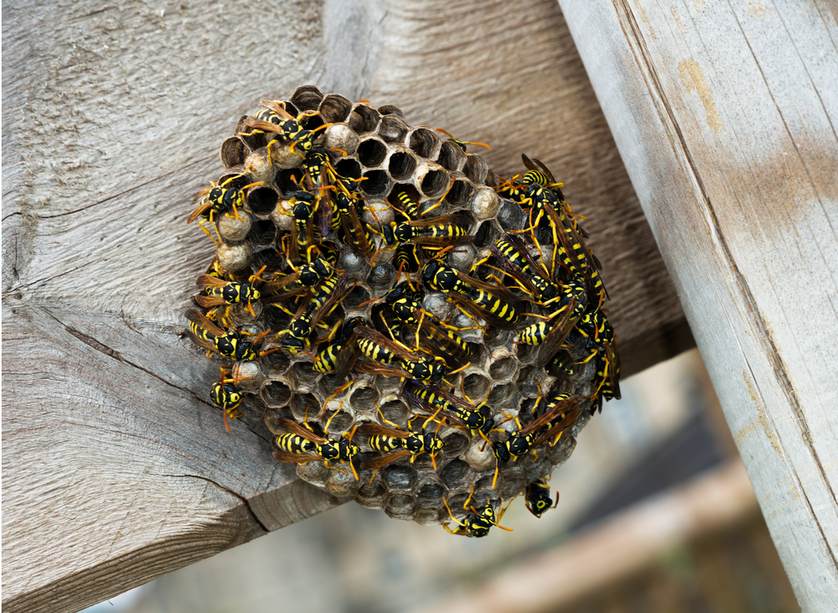HOME
Confessions of a Hunter — Bumble bees, hornets and wasp…oh my!

By Andy Anderson
It’s August, which means hunting season is right around the corner. Hunters will soon begin to venture back into the woods to start prepping. Part of this annual ritual is checking out the deer stand, camp area and to getting things cleaned up. This is dangerous and will make you scream for your mamma if you are not prepared.
A few weeks ago I was clearing some fence line out. I had just cut the wire and kicked the wire fence to push it out of the vegetation and away from the T-post. It was then I realized I had just entered into a very painful situation. Now, I’ve been stung by honeybees, wasp, hornets, ground hornets and more, but what I had just angered was unlike anything I had ever experienced.
As I stepped back to move down to the next post, I heard a buzzing sound and the all too familiar bug flying around my face. I gave a quick swat of a hand, a swat that seemed to kick it all off. All of a sudden, BAMM! Before my mind could catch up and process what was happening, I had been hit four or five times in the head. As I turned to run, two more hit me in the back and right above my belly button.
I felt like I got a little distance from the attackers, but as I turned to check my six wounds, I see this black mass emerging from the ground, forming into a ball. I pick up the pace. I am digging in with each step in near panic, wanting to scream in fear of the pending pain that’s about to rain down me. As I am looking back, running as hard as I can at the moment, I trip. My combat training kicks in: I go with the fall, roll out left and pop up quick to get back on my feet. BAM! One more hits me right between the shoulder blades.
I slide around the front of the truck like Bo Duke, grab the driver’s door handle and jump in. A dirty little aerial assassin followed me into the truck! I jump out quick; it follows me out. I jump back in.
As I sit there, covered in sweat and dirt, the pain starts to radiate throughout my body, specifically my head. I had been stung at least nine times; six of the most painful were in the back of my head.
HOME
Preparing Spring Gardens

By Hannah Claxton | Editor
The North Texas area is located within USDA Hardiness zones seven and eight. The zones are categorized by predicted low temperatures for winter and timing of the first and last frosts.
Zone seven usually has winter low temps between 0 and 10 degrees F with the average date of the first frost falling between Oct. 29 and Nov. 15 and the average date of the last frost falling between March 22 and April 3.
Overall, these two zones have similar climates and growing conditions, making the options for timing and variety within a garden very similar.
In these zones, cool-season crops should go in the ground in March, meaning that soil preparation should start now.
To read more, pick up a copy of the January edition of North Texas Farm & Ranch magazine, available digitally and in print. To subscribe by mail, call 940-872-5922.

HOME
Equine Vaccinations

By Heather Lloyd
Vaccinations are a critical component of maintaining the health and well-being of horses, especially in environments where they are exposed to other animals, such as in the sport, show and performance arenas. Horses, like all animals, are susceptible to various infectious diseases that can spread quickly and cause serious harm.
A routine vaccination schedule helps prevent the spread of these diseases by preparing the horse’s immune system.
To read more, pick up a copy of the November edition of North Texas Farm & Ranch magazine, available digitally and in print. To subscribe by mail, call 940-872-5922.

HOME
Wichita Falls Area Cattlewomen

Having herds on a controlled breeding schedule means that we have a predictable calving schedule, and while it’s only over a couple of months, for us it does fall right after the start of the year. I lobby annually to call ours the “Winter calving season”, but I am outvoted and my husband still refers to it as Spring. Unlike producers in our Northern States, we don’t have to contend with brutally harsh winter weather, and on those rare times we do, thankfully it is not for extended periods. Regardless of whether you have a Spring or a Fall calving schedule, the health of a newborn calf begins with the mother’s health, and the mother’s health is largely dependent on the producer.
To read more, pick up a copy of the November edition of North Texas Farm & Ranch magazine, available digitally and in print. To subscribe by mail, call 940-872-5922.

-

 Country Lifestyles2 years ago
Country Lifestyles2 years agoScott & Stacey Schumacher: A Growth Mindset
-

 Country Lifestyles8 years ago
Country Lifestyles8 years agoStyle Your Profile – What your style cowboy hat says about you and new trends in 2017
-

 HOME8 years ago
HOME8 years agoGrazing North Texas – Wilman Lovegrass
-

 Outdoor10 years ago
Outdoor10 years agoButtercup or Primrose?
-

 Country Lifestyles5 years ago
Country Lifestyles5 years agoAmber Crawford, Breakaway Roper
-

 Country Lifestyles9 years ago
Country Lifestyles9 years agoJune 2016 Profile – The man behind the mic: Bob Tallman
-

 Country Lifestyles8 years ago
Country Lifestyles8 years agoDecember 2016 Profile, Rusty Riddle – The Riddle Way
-

 Equine1 year ago
Equine1 year agoThe Will to Win




